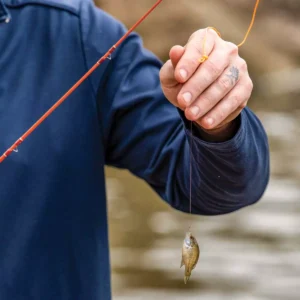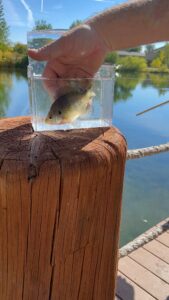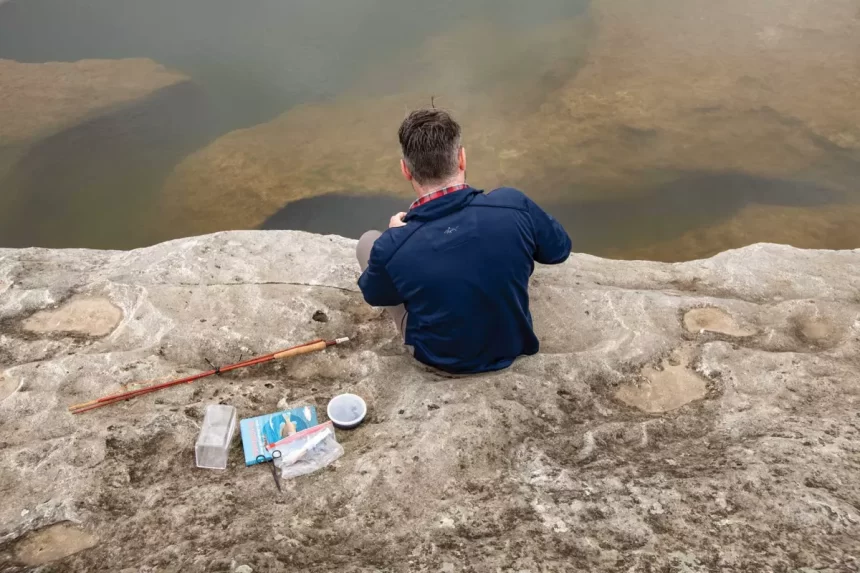This article originally appeared on our FWS website on November 30, 2022.
By Cindy Sandoval, USFWS
A popular fishing goal is hooking large fish, often called lunkers in the angling community. Anglers tell fish tales about the big one that got away and some even practice holding a fish closer to the camera to make it look larger in photos. However, a growing number of anglers are embracing the chase of small fish in a practice known as microfishing. As interest in microfishing grows, state fish and wildlife agencies are using Wildlife and Sport Fish Restoration Program (WSFR) Aquatic Resource Education grant funds to teach the unique fishing style and use microfishing to increase fishing and aquatic ecosystem education. Each year, Aquatic Resource Education grants support education opportunities for nearly 1.5 million people including the hundreds of students learning through microfishing clinics hosted by Texas Parks and Wildlife Department (TPWD) and their partners.
TPWD and partners hosts microfishing clinics to introduce adults and kids to the sport throughout the year. “Of the 169 Texas inland fish species, only 17 are considered game fish,” said Adam Comer, TPWD Aquatic Education Specialist. “The rest of the fish, typically what we consider minnows, are diverse, integral species, and present a good opportunity to learn about aquatic resources.” Texas has 191,000 miles of streams and 15 major river basins that create plenty of opportunity for microfishing often in participants own neighborhoods.
Comer provides fishing gear to clinic participants to get them started. This includes wooden dowels rigged with fishing line and small nymph hooks about a quarter the size of an average hook. He also provides bait in the form of biscuit mix with fish oil and worms. The lower cost of microfishing can appeal to those new to fishing as less than $50 of gear and bait can outfit newcomers. From wooden dowels to old fly rods a variety of equipment can be used since the angler is not casting far out into a waterbody. “One of the appeals of microfishing is that it is very approachable, we can teach about fish biology, fish habitat needs, and fishing techniques in a very accessible way,” added Comer.

Microfishing is also a celebration of biodiversity with anglers often catching over a dozen species in a single day. Some anglers also refer to microfishing as “species fishing” for this reason. Once examined through a microfishing lens, the forgotten shoreline “minnows” become unique darter, shiner, sucker, and dace species. Along with biodiversity education, the clinics also teach fishing ethics and catch and release strategies. Assessment and monitoring of fish and aquatic resources is also an important part of the U.S. Fish and Wildlife Service’s mission. “The U.S. has thousands of fish species that can be caught while microfishing,” said Jarrad Kosa, National Coordinator for Fish and Wildlife Conservation Offices. “Understanding what fish are being targeted and how to safely handle and return them to their habitat is an important aspect of this growing angling practice.”
To reduce stress on fish, one common microfishing tackle piece not found in traditional fishing is a small photo tank so anglers can document and photograph their catch without keeping the fish out of the water for extended periods. Along with smaller tackle and photo tanks, there is also an increasing number of digital tools for anglers to find and identify their catch and take measures to protect vulnerable species. Microfishing enthusiasts and beginners use mapping, photo sharing, and message boards on sites like iNaturalist and FishMap.org to share information.

“Increasing educational and fishing opportunities through our state and territory partners is a core value of Aquatic Resource Education grants,” said Christina Milloy, WSFR Fish and Wildlife Biologist. “Whether through traditional fishing clinics or microfishing clinics these funds support projects that enhance the public’s understanding of aquatic resources and fishing, and also promote responsible attitudes and ethics toward our aquatic environment.”
Traditional fishing clinics for popular sportfish species like bass and catfish are still a large part of Comer’s work. In addition to facilitating and leading over 20 outreach and fishing events and classes last year, Comer held nine online and in-person volunteer instructor workshops to train and certify community members to develop and lead classes and events in their communities. Additional specialty clinics and events supported by Comer included an online Intro to Microfishing class and a “Catch, Cook, Clean” class preparing Black Drum. “Most of our work involves traditional sportfishing activities but providing opportunities for those that might be less interested in fishing for these species or are looking for a different reason to get outdoors allows us to teach about our aquatic resources and the ethics of fishing,” added Comer.
Learn more about TPWD’s microfishing work at:

